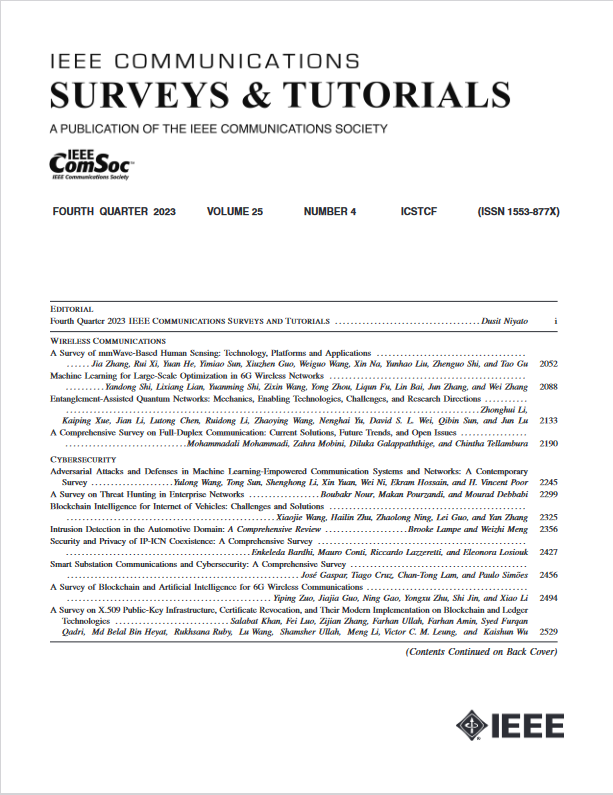基于机器学习的通信系统和网络中的对抗性攻击和防御:当代调查
IF 34.4
1区 计算机科学
Q1 COMPUTER SCIENCE, INFORMATION SYSTEMS
引用次数: 0
摘要
由于深度学习在通信网络中的应用迅速增长,机器学习和深度神经网络(DNN)中的对抗性攻击和防御受到了极大的关注。该调查提供了对抗性攻击和防御技术领域最新进展的全面概述,重点是基于dnn的通信应用分类模型。具体来说,我们根据攻击原理对最近的对抗性攻击方法和最先进的对抗性防御技术进行了全面的分类,并以视觉上吸引人的表格和树形图的形式呈现出来。这是基于对现有作品的严格评估,包括对其优势和局限性的分析。我们还将这些方法分为反击检测和鲁棒性增强,并特别关注基于正则化的增强鲁棒性的方法。还探索了新的攻击途径,包括基于搜索的,基于决策的,基于dropbased的和物理世界的攻击,并提供了最新防御方法的分层分类,突出了平衡训练成本和性能的挑战,保持干净的准确性,克服梯度掩蔽的影响,并确保方法可转移性。最后,总结了研究的经验教训和面临的挑战,并提出了未来的研究机会。本文章由计算机程序翻译,如有差异,请以英文原文为准。
Adversarial Attacks and Defenses in Machine Learning-Empowered Communication Systems and Networks: A Contemporary Survey
Adversarial attacks and defenses in machine learning and deep neural network (DNN) have been gaining significant attention due to the rapidly growing applications of deep learning in communication networks. This survey provides a comprehensive overview of the recent advancements in the field of adversarial attack and defense techniques, with a focus on DNN-based classification models for communication applications. Specifically, we conduct a comprehensive classification of recent adversarial attack methods and state-of-the-art adversarial defense techniques based on attack principles, and present them in visually appealing tables and tree diagrams. This is based on a rigorous evaluation of the existing works, including an analysis of their strengths and limitations. We also categorize the methods into counter-attack detection and robustness enhancement, with a specific focus on regularization-based methods for enhancing robustness. New avenues of attack are also explored, including search-based, decision-based, drop-based, and physical-world attacks, and a hierarchical classification of the latest defense methods is provided, highlighting the challenges of balancing training costs with performance, maintaining clean accuracy, overcoming the effect of gradient masking, and ensuring method transferability. At last, the lessons learned and open challenges are summarized with future research opportunities recommended.
求助全文
通过发布文献求助,成功后即可免费获取论文全文。
去求助
来源期刊

IEEE Communications Surveys and Tutorials
COMPUTER SCIENCE, INFORMATION SYSTEMS-TELECOMMUNICATIONS
CiteScore
80.20
自引率
2.50%
发文量
84
审稿时长
6 months
期刊介绍:
IEEE Communications Surveys & Tutorials is an online journal published by the IEEE Communications Society for tutorials and surveys covering all aspects of the communications field. Telecommunications technology is progressing at a rapid pace, and the IEEE Communications Society is committed to providing researchers and other professionals the information and tools to stay abreast. IEEE Communications Surveys and Tutorials focuses on integrating and adding understanding to the existing literature on communications, putting results in context. Whether searching for in-depth information about a familiar area or an introduction into a new area, IEEE Communications Surveys & Tutorials aims to be the premier source of peer-reviewed, comprehensive tutorials and surveys, and pointers to further sources. IEEE Communications Surveys & Tutorials publishes only articles exclusively written for IEEE Communications Surveys & Tutorials and go through a rigorous review process before their publication in the quarterly issues.
A tutorial article in the IEEE Communications Surveys & Tutorials should be designed to help the reader to become familiar with and learn something specific about a chosen topic. In contrast, the term survey, as applied here, is defined to mean a survey of the literature. A survey article in IEEE Communications Surveys & Tutorials should provide a comprehensive review of developments in a selected area, covering its development from its inception to its current state and beyond, and illustrating its development through liberal citations from the literature. Both tutorials and surveys should be tutorial in nature and should be written in a style comprehensible to readers outside the specialty of the article.
 求助内容:
求助内容: 应助结果提醒方式:
应助结果提醒方式:


